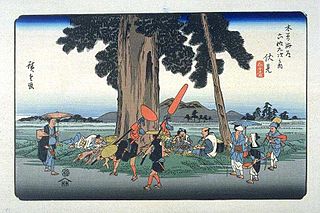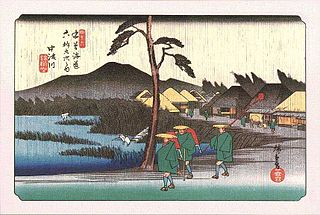 W
WAkasaka-juku was the fifty-sixth of the sixty-nine stations of the Nakasendō. It is located in the present-day city of Ōgaki, Gifu Prefecture, Japan. It flourished during the Edo Period, as it was located in a fertile valley, next to a river.
 W
WFushimi-juku was the fiftieth of the sixty-nine stations of the Nakasendō. It is located in the present-day town of Mitake, Kani District, Gifu Prefecture, Japan.
 W
WGōdo-juku was the fifty-fourth of the sixty-nine stations (shukuba) of the Nakasendō. It is located in the present-day city of Gifu, Gifu Prefecture, Japan. Gōdo-juku flourished as a post town because it was located next to the Nagara River and there was a ferry service to the other side..
 W
WHosokute-juku was the forty-eighth of the sixty-nine stations of the Nakasendō during the Edo period and it is located in the present-day city of Mizunami, Gifu Prefecture, Japan.
 W
WImasu-juku was the fifty-ninth of the sixty-nine stations of the Nakasendō. It is located in the present-day town of Sekigahara, Fuwa District, Gifu Prefecture, Japan.
 W
WKanō-juku was the fifty-third of the sixty-nine stations of the Nakasendō. It is located just south of JR Gifu Station in Gifu, Gifu Prefecture, Japan. During the Edo period, it was an independent post town that was approximately 2.3 km (1.4 mi) wide, making it the largest post towns in Mino Province.
 W
WMagome-juku was the forty-third of the sixty-nine stations of the Nakasendō, an ancient road that connected Kyoto and Edo during the Edo period. It was also the last of eleven stations along the Kisoji, which was the precursor to a part of the Nakasendō, running through the Kiso Valley. This well-preserved section of the old route is in the present-day city of Nakatsugawa, Gifu Prefecture, Japan.
 W
WMieji-juku was the fifty-fifth of the sixty-nine stations of the Nakasendō. It is located in the present-day city of Mizuho, Gifu Prefecture, Japan. This post town received its name from Mie-ji, a temple which was located in Mizuho during the Edo period. Saitō Dōsan, during his reign of power, moved the entire temple to the present-day city of Gifu.
 W
WMitake-juku was the forty-ninth of the sixty-nine stations of the Nakasendō. It is located in the present-day town of Mitake, Kani District, Gifu Prefecture, Japan.
 W
WNakatsugawa-juku was the forty-fifth of the sixty-nine stations of the Nakasendō. It is located in the present-day city of Nakatsugawa, Gifu Prefecture, Japan. During the Edo period, Nakatsugawa-juku reached a population of over 1,230 people and contained over 175 homes. There are many historical artifacts remaining today, including a stone monument with a haiku written by Matsuo Bashō.
 W
WOchiai-juku was the forty-fourth of the sixty-nine stations of the Nakasendō. It is located in the present-day city of Nakatsugawa, Gifu Prefecture, Japan. The honjin and the sub-honjin, as well as some old street lights, remain from the Edo period. The Honjin were the main rest areas in old post towns and very few remain today. There are ten hills that must be traversed to get to Ochiai-juku from the preceding post town of Magome-juku.
 W
WŌgaki-juku was the eighth of nine post stations along the Minoji. It is located in the present-day city of Ōgaki, Gifu Prefecture, Japan. In addition to serving as a post station, it was also a castle town to the Ōgaki Domain's Ōgaki Castle. Its dual role is very similar to that of the nearby Kanō-juku along the Nakasendō.
 W
WŌi-juku was the forty-sixth of the sixty-nine stations of the Nakasendō. It is located in the present-day city of Ena, Gifu Prefecture, Japan. From Ōi-juku to the next post town, Ōkute-juku, there are 13 hills to pass over. Travellers using the Shitakaidō (下街道) often used Ōi-juku, too, as they travelled on to Makiganetsui (槙ヶ根追) afterwards.
 W
WŌkute-juku was the forty-seventh of the sixty-nine stations of the Nakasendō during the Edo period. This is the first station along the Nakasendō to be in the domain of the Owari clan, one of the most powerful regional clans. It is located in the present-day city of Mizunami, Gifu Prefecture, Japan. Alternative kanji for the post town are 大久手.
 W
WŌta-juku was the fifty-first of the sixty-nine stations of the Nakasendō during the Edo period. It is located in Minokamo, Gifu Prefecture, Japan. It was located on one of the more difficult parts of the Nakasendō, but relics from its days as a post town still remain today. There are tours and programs available to introduce this old post town to visitors, including the Ōta-juku Nakasendō Museum.
 W
WSekigahara-juku was the fifty-eighth of the sixty-nine stations of the Nakasendō. It is located in the present-day town of Sekigahara, Fuwa District, Gifu Prefecture, Japan.
 W
WTarui-juku was the fifty-seventh of the sixty-nine stations of the Nakasendō. It is located in the present-day town of Tarui, Fuwa District, Gifu Prefecture, Japan.
 W
WUnuma-juku was the fifty-second of the sixty-nine stations of the Nakasendō. It was also the last post station on the Inagi Kaidō. It is located in the present-day city of Kakamigahara, Gifu Prefecture, Japan. The eastern and western portions of the old post town joined together to become a formal post town in 1651. Unuma-juku is approximately six kilometers from the preceding post town, Ōta-juku.